Variety Show 2019
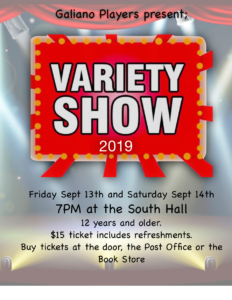 Coming Friday Sept 13th and Saturday September 14th!!! Come be impressed by your incredibly talented (or un-selfconscious) island neighbours.
Coming Friday Sept 13th and Saturday September 14th!!! Come be impressed by your incredibly talented (or un-selfconscious) island neighbours.
It’s an annual tradition not to be missed!!!
By Alison Colwell|2019-07-22T11:24:04-07:00July 22nd, 2019|Categories: Club Programs, Galiano Players|0 Comments
 Coming Friday Sept 13th and Saturday September 14th!!! Come be impressed by your incredibly talented (or un-selfconscious) island neighbours.
Coming Friday Sept 13th and Saturday September 14th!!! Come be impressed by your incredibly talented (or un-selfconscious) island neighbours.
It’s an annual tradition not to be missed!!!
By Alison Colwell|2019-07-22T11:20:41-07:00July 22nd, 2019|Categories: Club Programs|0 Comments
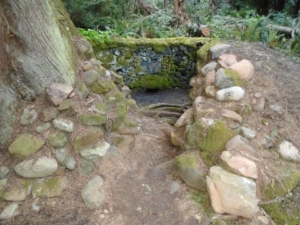 Charcoal making is an ancient art dating from 6000-8000 BCE.
Charcoal making is an ancient art dating from 6000-8000 BCE.
In a carefully controlled process known as pyrolysis, all moisture and most of the volatile materials contained in wood are removed, leaving almost pure carbon. The resultant charcoal burns at 600 to 1200 degrees Celsius, producing an even, smokeless heat.
Preparation
To prepare the kiln on this site for firing, a crib floor was laid over cedar logs set lengthwise above a subfloor,with channels for the air to flow from the entrance to the flues. On top of the crib was packed a floor of sand and dirt.
Loading
20cm diameter logs of alder (sometimes fir or maple) were stacked vertically side by side, reducing in diameter toward the front opening.
Capping
Once the kiln was filled, a thick layer of sticks and branches were placed over the logs. These were covered using a sand-clay-soil mixture, packed firmly to make a dome of 20cm thick.
Protection
The kiln would also have had a framed roof to protect the firing process from rain, as charcoal making was mostly done in autumn
Air Flow
This pit kiln has a typical teardrop design, dug out of the slope and forming an earthen mound lined with stone. Two flues are built half-way up into the walls and a metre away on each side of a central outlet chimney; all help regulate the flow of air, and control the heat.
Insulation and Drainage
15cm below the floor, a hidden subfloor of split cedar logs was laid across the width of the pit. This subfloor had two purposes: to act as an insulator for the ground heat, and to drain moisture and volatile acids toward the central chimney in order to be burned out.
The Process
The charcoal maker would light the fire at the narrow front opening, and then give his full attention to the burning. At the beginning white smoke would pour out the flues and it would take the day to get the kiln going.
A large tub of water would have been kept nearby in the event that a fire broke through the dome. If it did,water and more sand-clay mixture would be used to repair the leak. As the temperature in the kiln rose, moisture and volatile acids would be released from the logs, and the entrance way would be closed except for a small air intake.
The charcoal maker would judge the conditions in the kiln by observing the four stages of carbonization, revealed by the colour of the gases coming out the flues: white, yellow-white, blue and finally translucent. A slight odour of alder wood – not smoke – would be the sign to end the smoldering by covering the air intake and the three flues.
With all oxygen cut off to the kiln, carbonization would be complete. After one or two days’ wait to make sure the fire was out, the kiln was ready to be opened. The charcoal would then be removed, packed into rice sacks for market and taken down the hill to be loaded onto boats in Active Pass.
A century later, charcoal is still widely used, for barbecues, filtration, odour removal, art materials, smelting, soil enhancement and even as an ingredient in cosmetic products.
By Emma Luna Davis|2020-04-12T23:45:22-07:00July 18th, 2019|Categories: Food Program, Growing (Garlic Co-op, Greenhouse, Gleaning Project)|0 Comments
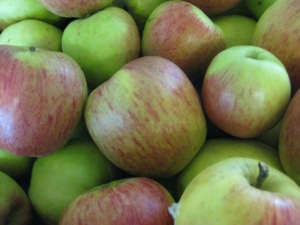 Recently at a Food Literacy conference in Victoria, I was asked to share a story of a moment I saw food literacy in action. I had so many to choose from! But what came to mind was the many times I’ve witnessed volunteer fruit pickers participating in the Gleaning Project who share recipes and techniques for handling the produce we are picking. “Can you dry this variety of apple?” “Have you ever made plum sauce for using in Asian recipes?” “I never get around to processing these, my kids just eat them all fresh.” And, every year: “What do you DO with quince?”
Recently at a Food Literacy conference in Victoria, I was asked to share a story of a moment I saw food literacy in action. I had so many to choose from! But what came to mind was the many times I’ve witnessed volunteer fruit pickers participating in the Gleaning Project who share recipes and techniques for handling the produce we are picking. “Can you dry this variety of apple?” “Have you ever made plum sauce for using in Asian recipes?” “I never get around to processing these, my kids just eat them all fresh.” And, every year: “What do you DO with quince?”
The Gleaning Project organizes groups of volunteer pickers to pick excess fruit (and sometimes vegetables). The harvest is divided 3 ways: One third for the landowner, one third for the Food Program, and one third divided amongst the picking volunteers. The Food Program share is used in our events, as well as distributed via the clinic, school and food bank. We gather all of the harvest together first and weigh everything so we can do things as fairly as possible, and so we can keep an accurate record for our notes and our funders. It’s an exercise in working communally, and everyone takes home some fruit picked by each of the volunteers.
We are very grateful to the landowners who generously host us, and work hard to be respectful of their space and property. That means we schedule picking times that are convenient to them.
When we have a site that is ready to pick, we email the volunteer pickers to inform everyone of the opportunity. We try to give you as much notice as possible, but often the window is pretty tight – ripe fruit waits for no picker!
We work hard to gauge the right number of pickers, taking into consideration how much fruit there is and what we can safely manage at each site. Sometimes there are more people interested than we can accommodate—please know that we do our best to make sure everyone gets a chance to pick and if we say no to you for one pick, you’ll probably be first in line for the next opportunity. This does mean that each person should not expect to pick more than a handful of times each season. How often you can expect to pick depends on your availability and how bountiful a harvest we have from year to year—last year about 80 people participated in about 60 picking sessions.
If you are offered a chance to pick, please take that commitment seriously. We know that things come up and sometimes it is necessary to cancel—in that case please give us as much notice as possible so we can replace you with someone who is keen. That lets us visit a site with the right number of pickers and get all the ripe fruit, rather than have to return multiple times to the same site. And some people want to pick but they don’t have a use for all of their share. If this is the case for you, please let us know when you ask to pick.
So, if you are you a landowner whose fruit trees are dripping with fruit, but you have no time to pick them; or if you would you benefit from having access to healthy fruit but have no fruit trees of your own; if your garden is overflowing, and you would you like to share the bounty with other members of the community; or if you enjoy the simple joy of harvesting fruit or vegetables in a group, the Gleaning Project is for you!
If you would like to be notified about upcoming picking sessions, or if you have trees that need picking, or if you have any questions at all, please email Emma.
By Alison Colwell|2019-07-18T17:18:17-07:00July 18th, 2019|Categories: Food Program, School Projects|0 Comments
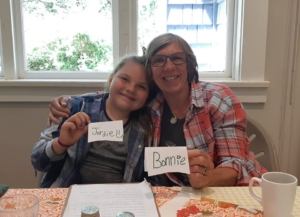 Afternoon Tea with Games
Afternoon Tea with Games
In May we tried a new event: An Afternoon Tea with Games. This idea sprang from requests we’d received from seniors. Some felt that our popular Thursday Games Night can be a little loud. (Admittedly Games Night can be a raucous affair with kids playing Twister and Hungry Hippo, and adults playing Ping Pong and Scrabble – who knew scrabble was so competitive?) So we decided to try a quieter games afternoon.
A dozen seniors showed up for our inaugural event. The majority played cards, though once again scrabble made an appearance, and all enjoyed a classic afternoon tea of scones, sandwiches and cake. Plus while they were playing the volunteers and I made dinner for anyone who wanted to eat at the end of the afternoon, or take something home with them for later.
So if a quieter games afternoon might be something you’d enjoy – then mark your calendar. We’ll try another one on September 26th at 1:30pm till 3:30pm – Come join us. (I promise there won’t be any Twister!)
CRFair Roundtable
On June 3, Emma attended the Capital Region Food and Agriculture Initiatives Roundtable on Food Literacy. There were interesting discussions about Food Justice, mostly around indigenous issues of land use and also barriers for refugees, and programs that are tackling these. There is a new food atlas at https://foodatlas.ca/ which includes the Southern Gulf Islands – check it out.
Gleaning Project
The Gleaning Project is in full swing for another season. We are once again organizing groups of people to pick surplus fruit, to be shared between the pickers, the landowners, the Food Bank and the Food Program. If you would like to be notified about picking sessions, please let Emma know and we’ll add you to our list. If you have trees that need picking, please email Emma.
Grandparents & Elders Lunch
On Tuesday June 1th Cathy’s class walked to the hall to cook lunch for 25 seniors. The kids did really well and the elders really enjoyed their lunch, with lots of lively intergenerational conversation happening around the room.
By Alison Colwell|2019-07-17T13:34:00-07:00July 17th, 2019|Categories: Cinema Galiano|0 Comments
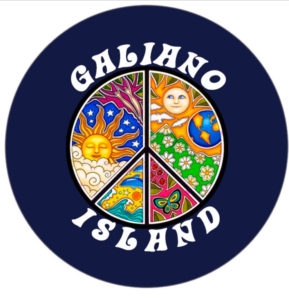 Cinema Galiano is pleased to announce we will be presenting the director’s cut of the film Woodstock Saturday, August 17th at 7:00 – exactly 50 years to the day that the original event occurred.
Cinema Galiano is pleased to announce we will be presenting the director’s cut of the film Woodstock Saturday, August 17th at 7:00 – exactly 50 years to the day that the original event occurred.
The $15 admission ticket includes Alison’s awesome pizza and sweet treats during the intermission at 9 and unlimited popcorn. We are setting the Hall up so that you can dance and peace out during the movie showing.
We’ll figure out a prize for best costume too! Bring out the old bell bottoms, tie dyes, etc.!
By Alison Colwell|2022-03-15T22:02:20-07:00July 17th, 2019|Categories: Club News|1 Comment
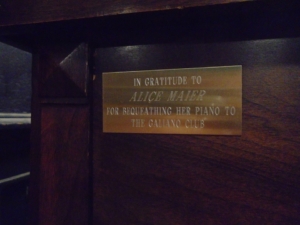 The Community Hall has an historic upright piano bequeathed to the Galiano Club by Alice Maier. It has had a home in the Hall since at least the 1990s.
The Community Hall has an historic upright piano bequeathed to the Galiano Club by Alice Maier. It has had a home in the Hall since at least the 1990s.
Used in countless local musical productions, school concerts, etc, the piano has also been played by several visiting musical celebrities. Jon Kimura Parker, the famed Canadian pianist, has performed on it during at least a couple Galiano Concert Society recitals & was delighted with the sounds the old piano produced.
Researching the piano’s serial number, local musician, Will Guthrie, has discovered that the instrument was produced in 1925 by The Weber Piano Co, Kingston, Ontario. The piano bears the name ‘Stevenson’ which, he was told, is probably the dealership’s name — a common practise at the time.
By Allan Forget|2022-03-15T22:01:46-07:00July 12th, 2019|Categories: Club News|0 Comments
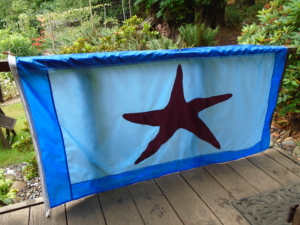
In 1999, the 75th Anniversary of the founding of the Galiano Club, Board of Directors President, Robin Ridington, asked for ideas on how to celebrate the event. Director and flag-enthusiast, Peter Renner, offered to organize an island wide ‘Galiano Flag’ contest. Club member & fellow flag-enthusiast, Allan Forget, volunteered to help. Advice was then sought from The Flag Shop (Victoria).
After some advertising in the local press 30 designs were submitted. These were given public exposure for several weeks on the walls of the island’s Trincomali Bakery & opinions were sought.
The Times Colonist (Victoria) newspaper reported, “Some of the submissions were hilarious. There were quite a few quasi-Tibetan things, lots of sunrises, eagles and mountains. Some proposed flags were more like political statements. One design featured the road from the island’s Ferry Terminal with a barricade that said “go away.” “
A half-dozen Galiano organizations were then asked to choose a rep to become members of a Flag Selection Committee to be chaired by Jamie Webb, Manager of the Flag Shop (Victoria).
After some deliberation the ‘Starfish’ design — “a purple starfish floating on an ocean of blue surrounded by a sky of blue” — created by Marina Szijarto and Linda Lopez, was chosen.
The Flag Shop created the first copy of this new Galiano Flag free of cost and offered to keep the design on file in its Victoria shop for future use.
The official flag raising ceremony was held November 20th, 1999 as part of that day’s Christmas Market (annually organized by the Galiano Club). A flagpole had been newly installed at the front of the Community Hall (by Dennis Olsen). With the Galiano Singers, MP Gary Lunn (Saanich & the Islands) and the island’s resident RCMP in attendance, a brief ceremony was held and a few dozen residents cheered as the flag was flown for the very first time.
The flag was offered for sale by The Flag Shop & by at least one island business
The Galiano Flag has continued to fly at the Community Hall ever since. In 2020 the Galiano Club Board voted to designate the ‘Starfish’ design as the official Club flag.